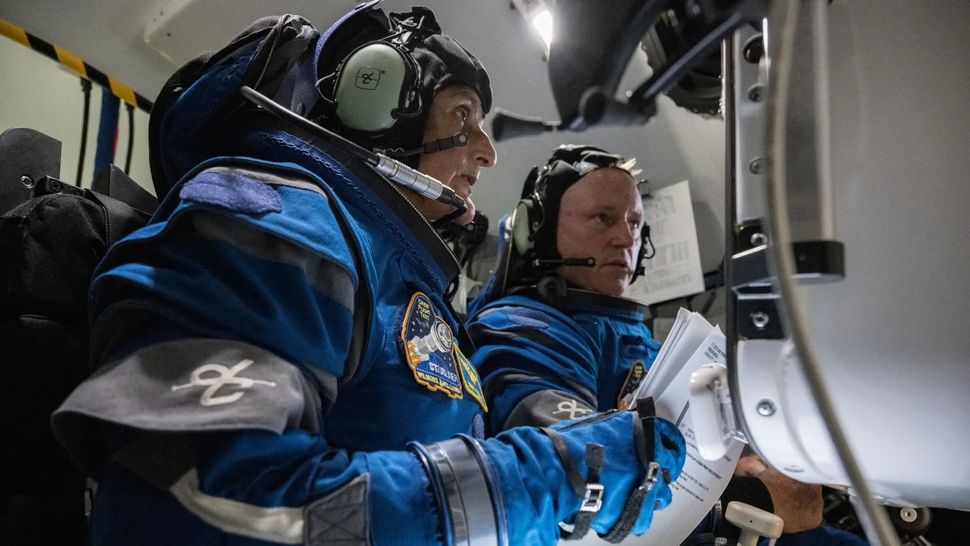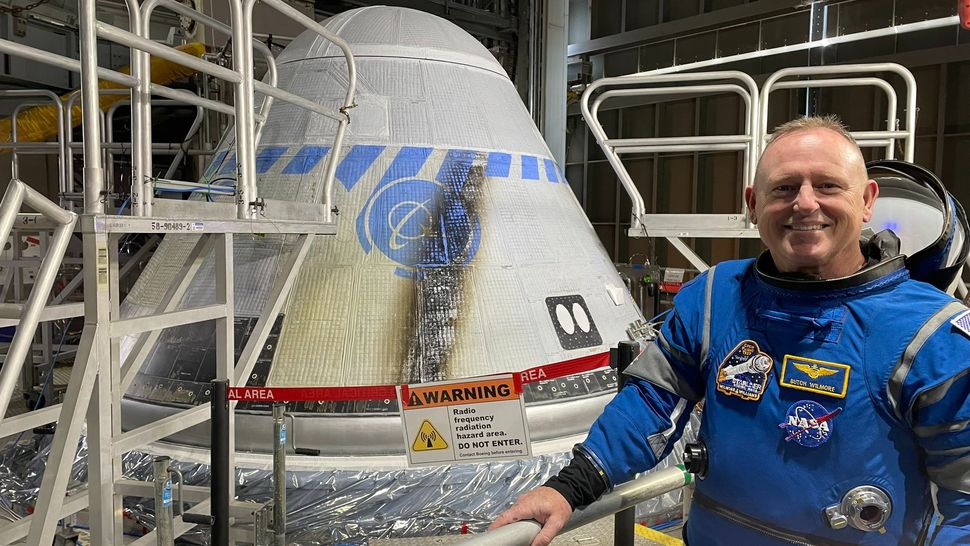The Boeing Starliner teams are currently working on diagnosing a helium leak in preparation for the astronaut launch scheduled for June 1st
'It's so convoluted:' Boeing Starliner groups diagnosing helium spill in front of June 1 space traveler send off
"We simply had to manage it collectively."
Starliner is as yet set to fly on its noteworthy first trip with space travelers on June 1, yet that could change as the group manages "confounded" issues following a little helium spill.
NASA and Boeing authorities accentuated they are cautiously gauging the choice to send off Starliner's most memorable test mission with space travelers to the Global Space Station (ISS). The around one-week mission is known as Team Flight Test (CFT) and incorporates NASA space explorers Butch Wilmore and Suni Williams, both previous U.S. Naval force aircraft testers.
"It's so convoluted. There's such countless things going on. We simply had to manage it collectively," Ken Bowersox, partner chairman for NASA's Space Tasks Mission Directorate and a previous space explorer, told correspondents in a video chat Friday (May 24). He added that resolving the issues have taken a great deal of time, which is important for why not many updates have been impending from the group lately.
A delta flight status survey on Wednesday (May 29) will occur to survey the hole and the progressions in which the group might do a deorbit consume, if fundamental. This is a piece unique in relation to the standard flight preparation survey as the break human confirmation report for CFT changed due to this new circumstance, he added. NASA will then hold one more call with columnists on Thursday (May 30), organization authorities said.
Starliner was postponed from its May 6 send off endeavor, just a short time before takeoff, because of an oxygen help valve issue on the Map book V rocket set to send off the space travelers from the waterfront Cape Canaveral Space Power Station close to Orlando, Florida. Joined Send off Union (ULA), the organization that makes the rocket, chose to supplant the "humming" valve, which was opening and shutting quickly.
That valve trade worked out as expected by May 12, however another issue — a helium spill in Starliner — was found after the send off clean. Analyzing what occurred, and how to settle it, required pushing back the days for kickoff a few times, most as of late to no sooner than June 1.
During the video chat, NASA and Boeing authorities said assuming the Starliner spill had occurred in space, they would have tracked down ways of managing it there; they underscored the hole was minuscule and that equipment can flop suddenly even on completely ensured rocket frameworks.
"There's no human-appraised vehicle that doesn't encounter this sort of oddity," said Boeing's Imprint Nappi, VP and program supervisor of the organization's business team program. (In different pieces of the question and answer session, models were given from SpaceX's Group Winged serpent, likewise utilized for business team flights, and the resigned space transport program that used to deal with NASA dispatches.)
Helium, as a non-latent gas, is certainly not an impending gamble to a send off. In any case, for all intents and purposes in a piece of the Starliner drive framework, it could influence the compression for little moves in circle. Beside concentrating on that break, NASA and Boeing have been attempting to figure out what the helium framework might actually mean for Starliner's re-visitation of Earth.
The hole is situated in one Aerojet Rocketdyne response control framework (RCS) engine that is situated in a solitary "doghouse," one of four such gatherings around the beyond Starliner's administration module. In a complex is "utilized to open and close valves on every one of the engines," said NASA's Steve Stich, program chief for the organization's business group program.
He said the circumstance made Starliner's group focus closer on the manifolds; while NASA says the pre-checks were strong, "perhaps in an ideal time period. We could have recognized this before." However that is definitively the job of an experimental drill, to distinguish such issues, he noted.
NASA, Aerojet Rocketdyne and Boeing are assessing around five answers for keep the break from repeating on future missions. That being said, Stich added, "Helium is a little particle. It will in general hole."
The break started at 7 pounds for each square inch (psi) and has expanded to between 50 psi and 70 psi, coming from a not as much as button-sized region in the Starliner space apparatus that is under 10 pieces of paper thick. (Specialists couldn't securely open up the defective spot while Starliner was stacked on its Chart book V in ULA's Upward Joining Office, so they have been breaking down the hole utilizing programming devices all things being equal.)
The hole is from an elastic seal that in the middle of between two metal pieces of a spine, which "keeps that interface tight so the helium can go through there," Stich said.
The other 27 engines in the RCS are not spilling by any stretch of the imagination, he stressed, and examination decided Starliner could deal with up to four more engine spills — or a hole of up to multiple times higher in this one zone. Also, engineers tried the framework through a few strain changes and the hole was "somewhat steady" through those changes, he said.
Stich said concentrating on the helium spill exposed a "plan weakness" in the impetus framework. There are three affirmed strategies in which Starliner could return home: Eight RCS engines, two orbital moving and mentality control (OMAC) engines, or four OMAC engines.
Yet, under "the right conditions of disappointments," meaning the deficiency of two manifolds of engines in neighboring doghouses, they could lose the capacity to fire eight RCS jets on the double and consequently, likewise lose a type of reinforcement.
"So we needed to avoid potential risk to comprehend, what could really be done in the event that we lost our engines? We've worked with the merchant of the engine [Aerojet Rocketdyne], Boeing and our NASA group to think of a repetitive technique to do with your consume: To split it up into two consumes, around 10 minutes each [and] 80 minutes separated, to concoct a four-RCS-engine deorbit consume and to recapture the capacity of the first framework.
"What's more, that set aside some margin for our group to go work through," he kept, saying it included NASA groups in direction and route, designs and drive close by Aerojet Rocketdyne and Boeing groups. "So we have that reestablished that overt repetitiveness for the reinforcement capacity in an extremely remote arrangement of disappointments for the deorbit consume."
The group effectively tried out this situation in a test system as of late, probable one of the great devotion ones at NASA's Johnson Space Center in Houston (where they stay in isolation.) This adjustment of the overt repetitiveness, notwithstanding, is one of the essential drivers behind the impending delta flight status survey on May 29 to survey the human confirmation for Starliner, Stich said. The group additionally needed to find opportunity to look at the helium hole and all fixes, in the wake of resting this Dedication Day weekend.
June 1 isn't a lock, as the work is still on progress, however a few reinforcement dates exist in the close to term: June 2, June 5 and June 6 are close term open doors for Starliner to send off, and there are different possibilities in the late-spring too.
Starliner would stay stable long past then, said Nappi. In any case, the Map book V rocket has a few sections that would terminate in June and July, said ULA's Gary Wentz, who is VP of government and business programs. Other send-offs may likewise need to move around assuming the defer endures.
CFT is simply permitted to dock at a solitary port of the Concordance module of the ISS, however "we're really adaptable all through the mid year" on the off chance that Starliner needs to hold, ISS program supervisor Dana Weigel told Space.com during the public interview.
As is valid for all send-offs, CFT wouldn't be planned to show up at the ISS on docking, undocking or spacewalking days on the ISS, however that port could stay void until essentially team pivot exercises in August, she said. Prior that month, a Northrop Grumman Cygnus will billet in a different port of the ISS, and assuming the CFT space travelers are on station around then they might assist with dumping exercises assuming time licenses.
Williams and Wilmore will get back to the Kennedy Space Center in Florida, where quarantine quarters are a couple of miles from the platform, a couple of days before send off. The ongoing June 1 send off would see them return on May 28.
The team has been in isolation for about a month, holding up through the deferrals, however are "feeling great," Bowersox said. Wilmore and Williams somewhat went to gatherings and among different remarks have asked the group to find a steady speed, he said. (As military space explorers and previous U.S. Naval force aircraft testers, the CFT group are utilized to both long arrangements as well as dealing with formative projects like Starliner, where timetable changes like this are normal.)
Boeing is the other merchant for business team beside SpaceX, after they were chosen for space explorer taxis in 2014. The underlying assumption for ran flights was 2017, however specialized and financing issues created setbacks. SpaceX has sent twelve missions to the ISS starting around 2020, acquiring from its freight Mythical beast configuration (first utilized in space in 2012) to educate the plan regarding Team Winged serpent.
Starliner, another shuttle, presently can't seem to convey space explorers on high. An uncrewed practice run in 2019 didn't proceed as expected; the space apparatus never arrived at the ISS after a product misfire stuck it in some unacceptable circle. The following endeavor in 2022 (postponed by the pandemic, and after many fixes were carried out), made it there with no issue.
CFT postponed again in 2023 after new issues were found with the parachutes
(which conveyed less burden than anticipated) and wiring (shrouded in combustible tape). Those issues are behind the group, Boeing and NASA have pushed more than once as of late.


